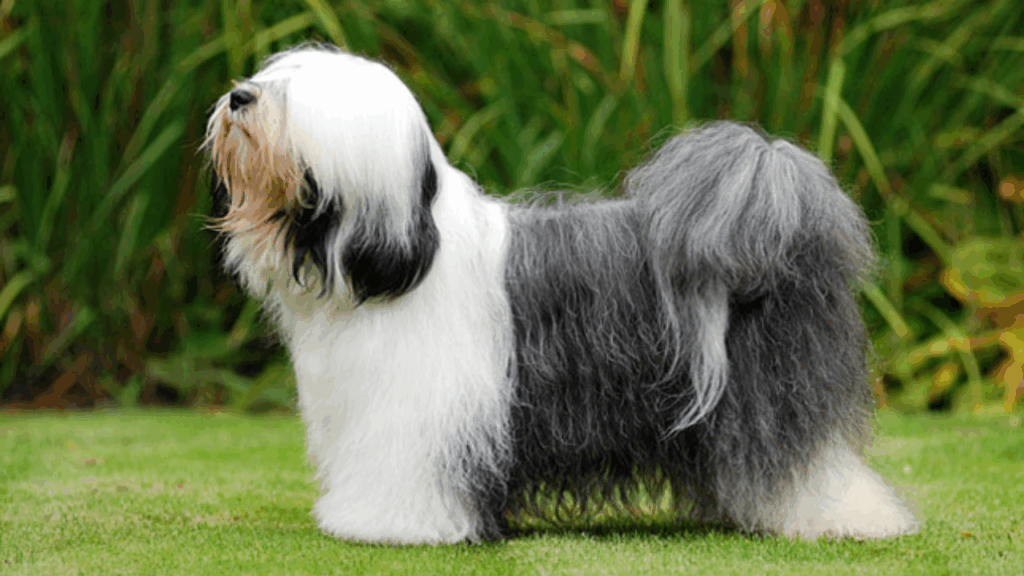The Tibetan Terrier, despite its name, is not actually a true terrier. This ancient breed hails from the remote, mountainous regions of Tibet, where it was revered by monks and families alike. Known for its shaggy coat, agile frame, and affectionate temperament, the Tibetan Terrier is both a loving companion and a symbol of good luck.
Origins and History
The Tibetan Terrier is a breed deeply embedded in the spiritual and cultural life of the Tibetan people. Bred by Buddhist monks in monasteries high in the Himalayas, these dogs were considered “holy dogs” and were believed to bring luck, protection, and prosperity. They were never sold but were gifted as tokens of goodwill or as blessings.
Although not a terrier by function (they were not bred to hunt or dig like traditional terriers), Western travelers who encountered the breed in the early 20th century gave it the name “Tibetan Terrier” because of its size and appearance.
The breed was first brought to Europe in the 1920s by Dr. Agnes Greig, a British doctor stationed in India who received a Tibetan Terrier as a gift. She began a breeding program, and the breed quickly gained popularity in the UK and beyond.
Physical Characteristics
The Tibetan Terrier is a medium-sized, well-balanced dog with a distinct appearance marked by a long, flowing coat and expressive eyes hidden beneath a curtain of fur.
Key features include:
- Height: 14–17 inches at the shoulder
- Weight: 18–30 pounds
- Coat: Long, profuse, and double-coated; the outer coat is fine and can be wavy or straight
- Colors: All colors are acceptable; common ones include white, black, gold, brindle, and combinations
- Tail: Set high and curls over the back
- Feet: Large, flat, and snowshoe-like—ideal for navigating snow and rocky terrain
These sturdy little dogs were often used by Tibetan families for multiple roles—guarding the home, herding livestock, and offering companionship.
Temperament and Personality
Tibetan Terriers are known for their intelligence, loyalty, and affectionate nature. They thrive as family dogs and are known to form strong bonds with their humans.
Personality traits:
- Gentle and loving with their family
- Alert and watchful, making excellent watchdogs
- Sensitive and intelligent, often described as having a strong intuition
- Independent, but not aloof; they enjoy being part of family activities
While generally friendly, Tibetan Terriers can be reserved with strangers, especially if not properly socialized early. Once they warm up, however, they become warm and engaging companions.
Exercise and Training
Despite their compact size, Tibetan Terriers are active and agile. In their native Tibet, they traversed mountainous paths and herded animals, so they are no strangers to physical activity.
Exercise needs:
- Daily walks and playtime are essential
- Enjoy games, agility, and light hiking
- Thrive in environments where they can explore and interact
In terms of training, Tibetan Terriers are highly intelligent but can be strong-willed. They respond best to positive reinforcement and gentle consistency. Harsh or overly strict methods can lead to stubbornness or anxiety.
Early socialization and puppy training classes are beneficial for helping them become well-mannered, confident adults.
Grooming and Care
One of the Tibetan Terrier’s most distinctive features is its luxurious coat, which requires regular grooming to keep it clean and mat-free.
Grooming essentials:
- Brushing several times a week (daily during shedding seasons)
- Bathing every few weeks or as needed
- Trimming around eyes and paws for cleanliness
- Regular ear cleaning, dental care, and nail trimming
Some owners opt to keep their Tibetan Terriers in a puppy cut for easier maintenance, especially if the dog is not being shown.
Health and Lifespan
Tibetan Terriers are generally healthy and long-lived, with a lifespan of 12–16 years. Responsible breeders screen for hereditary issues, but potential concerns include:
- Hip dysplasia
- Progressive retinal atrophy (PRA)
- Lens luxation
- Hypothyroidism
Regular vet checkups and a balanced diet help keep these dogs in top shape. They are sensitive to their environment and may not respond well to chaotic or high-stress households.
Ideal Living Environment
Tibetan Terriers are adaptable and do well in various living situations—city apartments, suburban homes, or rural areas—as long as they receive regular exercise and companionship.
They are wonderful with children and other pets, especially when raised together. However, they do not like to be left alone for long periods and may develop separation anxiety if isolated frequently.
Conclusion
The Tibetan Terrier is a loving, intelligent, and loyal companion with a fascinating history and endearing personality. With their striking appearance, adaptable nature, and affectionate temperament, they make ideal pets for families, couples, or individuals who can offer them time, attention, and care.
For those seeking a dog that brings together ancient mystique, a strong heart, and a touch of quirky charm, the Tibetan Terrier is truly a breed worth considering.

Andy Parker is a dog lover, writer, and senior editor at BarkPicks. With years of experience covering canine health, training, and gear, he helps pet parents make smarter choices for happier, healthier dogs. Andy shares his home (and heart) with two rescue pups, Charlie and Mia.



